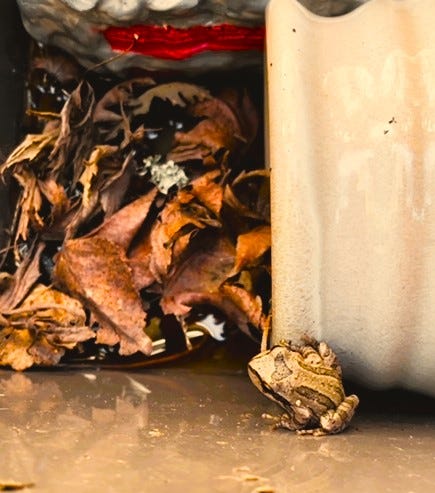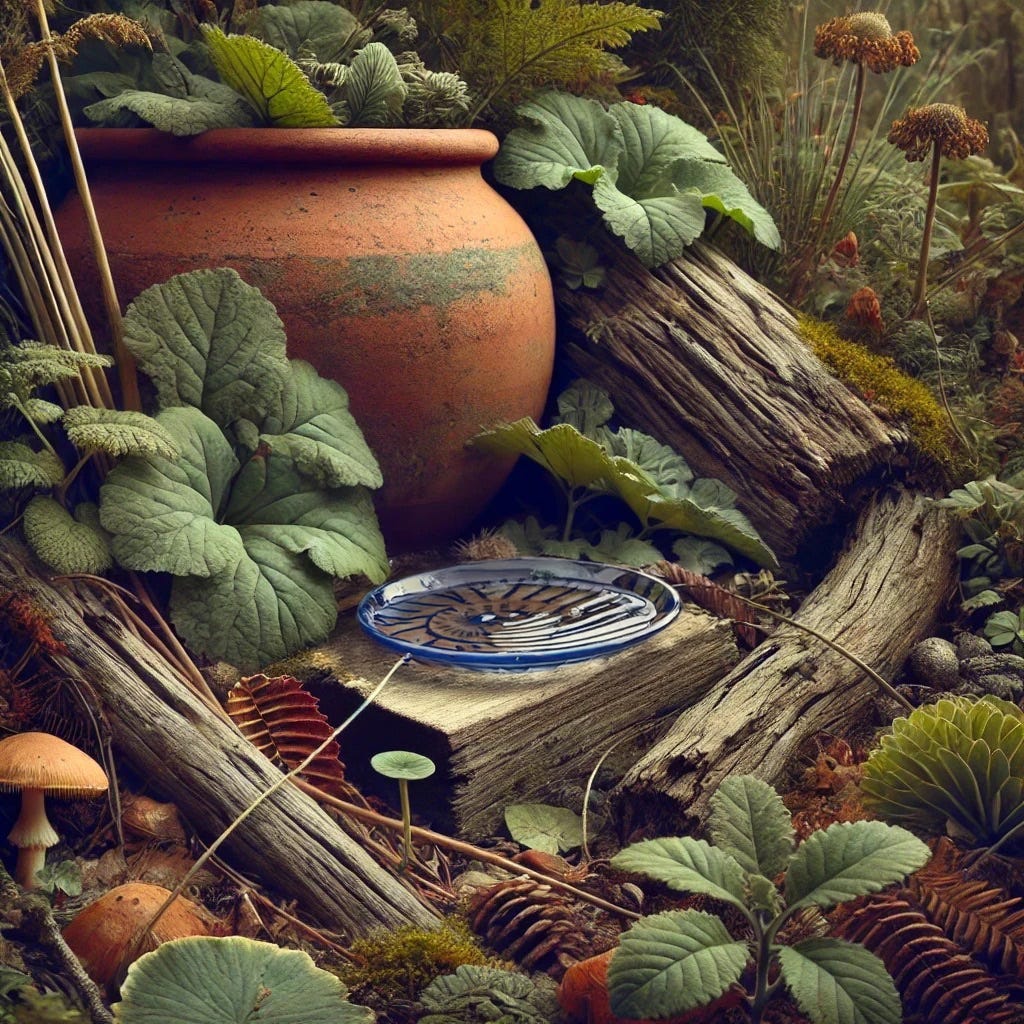Green Wednesday: Discovering the Matilija Poppy and Frog-Friendly Gardens
By Cindy Watter, UC Master Gardener of Napa County / Linda Joshua of Napa Climate NOW!
Most Wednesdays, Napa Valley Features includes posts from Napa Climate NOW!, a local nonprofit advocating for smart climate solutions, alongside the ongoing series by the U.C. Master Gardeners of Napa County, who share research-based horticultural advice. Together these organizations provide valuable insights into sustainable gardening practices and climate-related topics relevant to our region.
Today we delve into "Mastering the Matilija Poppy" by Cindy Watter of U.C. Master Gardeners of Napa County. Cindy introduces us to the fascinating Matilija poppy, a California native known for its dramatic blooms and paradoxical nature — both challenging to grow and highly invasive. She provides practical advice for cultivating this resilient plant, while sharing tips on how to manage its vigorous spread through careful propagation and maintenance.
We also hear from Linda Joshua of Napa Climate NOW! in "Frog in the Hose Hideaway." Linda recounts her delightful discovery of frogs sheltering in her garden and highlights the environmental benefits of creating frog-friendly habitats. Frogs, as natural pest controllers and sensitive bioindicators, play a crucial role in garden ecosystems, and Linda offers simple steps to attract and protect these valuable creatures in your own outdoor space.
Mastering the Matilija Poppy
By Cindy Watter
NAPA VALLEY, Calif. — The Coulter’s Matilija poppy (Romneya coulteri), a California/Baja native plant, is a paradox. It is described as both “difficult to grow” and “invasive.” How can that be?
Years ago I decided the poppy was the plant for me because of the second attribute. I bought a 1-gallon pot at the California Native Plant Society sale, took it home, planted it and it promptly died. How deflating! What did I do wrong?
The Matilija poppy thrives in full sun and needs very little water. As a California native, it is drought-tolerant. I had planted mine in partial shade and didn’t give it enough water. Even plants that thrive in dry landscapes need water until they are established. Live and learn.
The Matilija poppy is considered invasive because it sends out rhizomes that spread underground. If you don’t want it to take over your yard, cut back any sprouts that appear. If you want to propagate it, dig up the sprouts and plant them or give them to friends. The small sprouts have the best chance of success.
Supposedly you can also take cuttings from the thickest part of the stem and propagate those, but the chances of success are lower than when you carefully transplant the small volunteers. It’s best to plant these sprouts in the fall.
You can grow the Matilija poppy from seed, but it’s a challenge. The seeds will not sprout if you simply drop them on the ground. People who successfully grow Matilija poppies from seed follow a complicated — almost occult — ritual that involves burning pine needles over a heap of seeds to simulate the fire- and smoke-damaged landscape where the poppies are often found. That method seems risky in our climate, so I recommend buying the plant from a native-plant nursery or growing it from sprouted rhizomes.
The Matilija poppy thrives in full sun and needs very little water. As a California native, it is drought-tolerant.
When you get your plant, don’t disturb the roots. Cut out the bottom of the pot, put the pot in the planting hole with sandy, well-drained soil, and then cut the side of the pot and slide it off. Give the plant water regularly until it is established. After that, don’t water.
The UC Master Gardeners of Mariposa have a series on YouTube called “Propagating California Native Plants.” The first video in the series is on the Matilija poppy. Master Gardener Helen Willoughby-Peck walks the viewer through the process of “smoking” the seeds (which she shakes from an adorable dried seed pod). It looks like something I couldn’t do without burning off my eyebrows, but she then shows an easier way—with a bottle of Liquid Smoke! You want the genuine article that only contains water and smoke. Just sprinkle it on the seeds, which should be on top of a soil-filled pot, cover the seeds with shredded paper and a saucer, and put the pot in the garden to overwinter. Plant the seeds in the spring.
I was reminded of this plant when I visited the Saintsbury winery garden in Carneros a few months ago. They have Matilija poppies planted next to an office (with western exposure) and along a fence with roses. The poppies get plenty of sun and seem quite happy.
This shrub can grow to more than 8 feet tall and just as wide. It has blue-gray leaves and flowers that are 6 to 8 inches across — the largest blooms of any California native. The petals look like white silk crepe and are arranged around a fluffy yellow center, giving the appearance of a sunny-side-up egg. A large shrub covered with these blooms in early summer is a showstopper in any garden.
At Saintsbury the Matilija poppies share space with other natives and English roses, and it is a felicitous arrangement because the deciduous poppy dries out after blooming and is undistinguished-looking. UC Master Gardener Wes Janssen recommends cutting it back to 6 inches in late fall. Chop up the pruned stems and leaves and use as mulch around the base.
The Matilija poppy attracts butterflies and bees and has a pleasant scent. If you want it for a flower arrangement, cut it in the bud stage because the cut flower is short-lived.
This flower has an interesting history. Its name comes from a Chumash indigenous leader, Chief Matilija. The Chumash once lived in the area that stretches from Morro Bay to Malibu, concentrated near what is now Santa Barbara. Supposedly a grove of poppies guards the grave of the chief’s daughter in the hills above Matilija Canyon near Ojai. But the botanical name is Romneya coulteri, so who were Romney and Coulter?
Thomas Coulter was an adventurous Irish botanist who traveled to Mexico in the 1830s. After failing at running a mine and then experiencing a political coup, Coulter found the spectacular poppy that had been used medicinally by the native people for centuries for stomach and gum ailments. Coulter Latinized the name of his good friend, the Irish astronomer Thomas Romney Robinson, for the poppy’s botanical name.
The Matilija poppy was a strong contender to be the state flower of California. The California poppy (Eschscholzia californica) won. It is just as invasive but easier to cultivate. However, there are many, many Matilija poppies in Napa Valley, enlivening the cultivated and wild landscape. Our Mediterranean climate and soil are perfect for them. They are also deer-resistant.
I’m not giving up, and I think I will try the Matilija poppy in my yard again. That’s the best thing about gardening — there’s always next year.
Workshop: Join UC Master Gardeners of Napa County for a “Water-Wise Plant Show” on Wednesday, Oct. 16, from 6:30 to 8:30 p.m., at the Pelusi Building, 2296 Streblow Drive in Napa. Local landscape designers will demonstrate that drought-tolerant is anything but boring. Register here.
Workshop: Join UC Master Gardeners of Napa County for a workshop on “Fall Garden Clean-up” on Saturday, Oct. 26, at Las Flores Learning Garden, 4300 Linda Vista Ave., Napa. Learn how we put the various garden plots to bed for the winter. There will be hands-on activities so that you can learn how to implement these techniques in your own garden. Register here.
Help Desk: The Master Gardener Help Desk is available to answer your garden questions on Mondays and Fridays from 10 a.m. until 1 p.m. at the University of California Cooperative Extension Office, 1710 Soscol Ave., Suite 4, Napa. Or send your questions to mastergardeners@countyofnapa.org. Include your name, address, phone number and a brief description. For best results attach a photo.
If today's garden-focused story captured your interest, explore these related articles:
Transform Your Garden — Embrace Low-Maintenance Native Plants
Weekender Encore: Nature’s Sweet Treasure — The Blackberries of Napa Valley
Cindy Watter is a UC Master Gardener of Napa County.
Frog in the Hose Hideaway
By Linda Joshua
NAPA VALLEY, Calif. — Imagine my surprise when I opened the top of my hose hideaway to water the garden recently and saw a frog — a handsome, plump, brownish-greenish-colored croaker. I was smitten. Since we don't have any kind of pond or water source and neither do our neighbors, I was also puzzled.
My immediate instinct was to protect it. It was a hot day, so I filled a shallow clay pot with water and found a broken pot half-filled with soil that I put into the casing. The equipment was well-shaded during the heat of the day, and predators could not easily get inside. I took one last peek, closed the lid and was on my way. End of frog adventure, I thought.
The next day I checked in on my visitor. The frog was still there, looking very comfortable indeed. And not only that, now he had a friend. This was a real pinch-me moment. Not only are frogs delightful to look at, but they are also true assets to the garden. Frogs and toads are carnivorous creatures that consume a multitude of insects such as mosquitoes, flies, caterpillars, beetles and even cockroaches. A single frog can eat more than 100 insects in one night, making it an outstanding form of environmentally friendly pest control.
These little critters were making me feel glad about my choice to take care of them.
Frogs and toads also serve as important bioindicators, often signaling environmental problems even before they become readily apparent to the human eye. Since their thin skin can quickly and easily absorb pollutants from both air and water, the presence of frogs and toads means that the environment is in good shape. If there are no harmful toxins present, there is enough natural vegetation to encourage insects and you provide cover from predators, you will have a healthy habitat. These little critters were making me feel glad about my choice to take care of them.
Sadly, frog and toad numbers are declining due to loss of habitat, escalating development, the spread of disease and, increasingly, climate change. Frogs like shady, damp spots where they can hide during the day.
Creating a shelter can be as simple as filling an area with leaves or stacking a log pile. If you want to get creative, put a terracotta pot on its side and partially bury it in the soil. A lot of water sources have disappeared, but by establishing one in your garden (being careful not to create a mosquito breeding ground) and making other frog-friendly changes, you can help boost their numbers.
I started up a discussion on Nextdoor that I accompanied with a picture, and I was happy to see that people were just as excited as I was to know I had had this hoppy encounter. No one agreed on who was visiting, however, or even if they were frogs or toads. Some said they were Pacific chorus frogs, Baja California tree frogs, Booroolong frogs, bullfrogs and just toads. Whatever they are, I am happy to have them. So far they have stayed two weeks, coming and going as they please.
My yard has become decidedly wild by choice. We use no pesticides, and I love my healthy insect population. As it turns out, this pays off when a frog visits your garden. Habitat loss is real, and if our actions are harming other animals, then we have a responsibility to try to reduce or repair the damage we have done. I’m grateful for a habitat healthy enough to support these remarkable creatures.
Want to attract some frogs and toads to your garden? Stop using pesticides, provide a water source, provide shelter and rewild your yard — or at least some part of it.
If today's story captured your interest, explore these related articles:
Green Wednesday: Fall Gardening Fun and Youth Climate Advocacy
Under the Hood: Climate Change's Growing Impact on Napa Valley
Pruning and Climate Adaptation Tips for Home Vineyards in Napa Valley
Dan Berger's Wine Chronicles: The Evolution of Wine in a Warming World
Black Sears Family Donates Land to Help Create Wildlife Corridor
Linda Joshua is a member of Napa Climate NOW!










Without knowing that it wouldn't work, I collected some seed two years ago and threw them in my "anything goes" raised bed and was happy to see a couple of plants grow and flower. Beautiful and long lasting.
I have often wondered about this plant. good information